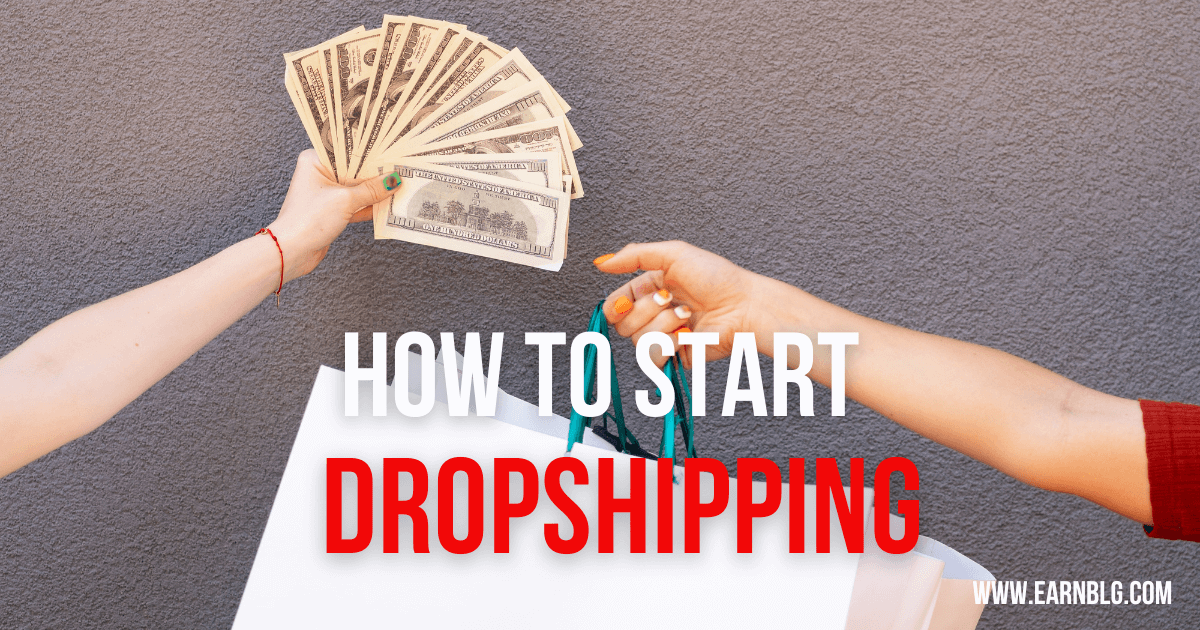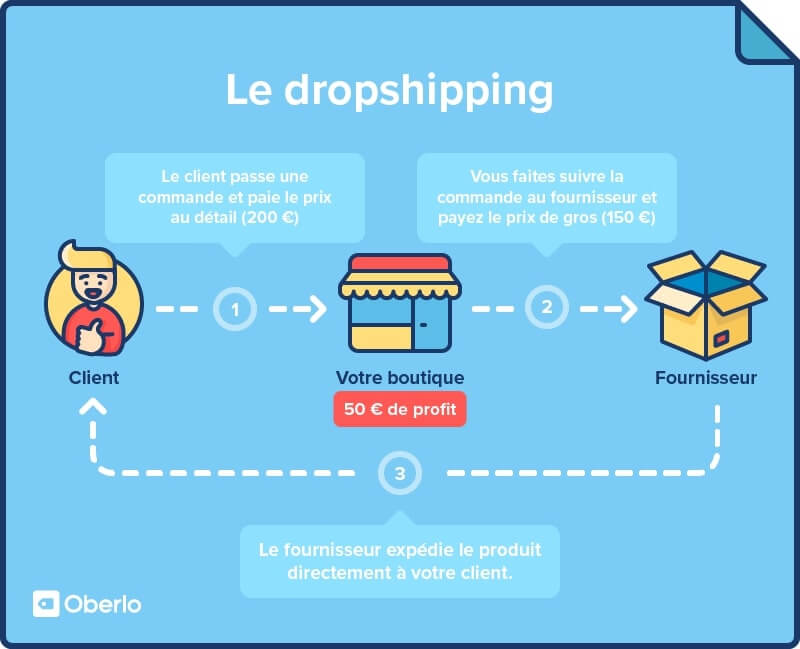How to Start a Dropshipping Business in 2023
Starting a dropshipping business constitutes an excellent initial stride into the realm of entrepreneurship. This journey empowers you to vend products to clientele, establish your product prices, and cultivate your distinctive brand.
Notably, there’s no obligation to fund inventory until it’s actually sold to a genuine customer. With dedicated effort, you have the potential to forge a triumphant brand.
The Lucrative Realm of E-commerce
For those who still deliberate embarking on an online venture, ponder this: in the year 2022, global e-commerce sales soared to a staggering 5.2 trillion dollars. These statistics unequivocally indicate that commencing an online enterprise is an increasingly rewarding avenue.
Unveiling the Path to Launch a Dropshipping Business
Delving into the depths of this article, you shall be enlightened on how to initiate a prosperous dropshipping business. We shall unveil the essence of a dropshipping business, illuminate the art of discovering apt dropshipping business concepts, and equip you with a comprehensive understanding to embark on this venture.
What Is a Dropshipping Business?
In essence, a dropshipping business materializes as a business model where you can oversee a store devoid of maintaining any inventory.
Following a successful sale, your supplier shall dutifully dispatch the products from their warehouse, directly to the customer’s doorstep. This translates to a liberating absence of concerns related to storage, packaging, or product shipping.
How Does the Dropshipping Business Model Work?
The mechanics of the dropshipping business model revolve around three pivotal participants: the manufacturer, the retailer (you), and the customer.
The manufacturer’s role encompasses the creation of products, the management of inventory, shipping products directly to customers on the behalf of the retailer, managing exchanges of defective products, and replenishing stock. They vend products to the retailer at wholesale rates while embracing the risk of unsold inventory.
In the realm of dropshipping, you, as the retailer, market the manufacturer’s products on your personal website under your distinctive brand. This entails the responsibility of selecting and promoting these products. Furthermore, you’ll shoulder the shipping expenses and ascertain pricing that renders a profit.
In the dropshipping milieu, the end customer purchases products directly from you, the retailer. In the event of queries or issues, the customer interfaces with the retailer from whom the product was acquired.
How Profitable is Dropshipping?
Frequently asked and rightfully so—how profitable is dropshipping? Dropshipping, by its very essence, can epitomize the epitome of profitability among business models.
The absence of shipping and manufacturing costs can culminate in swift profit generation once you secure the right suppliers. Rest assured, our dedicated Profit Margin Tool stands poised to aid you in meticulously calculating your profits, ensuring your journey charts a course to triumph.
Why Is Starting a Dropshipping Business a Good Idea?
A dropshipping enterprise radiates as a business model conducive to low risk. In the realm of startup expenses, you exclusively disburse for products that are successfully vended to paying patrons.
The cumbersome burden of creating products, maintaining unsold inventory, and financing employees for packaging and shipping is conveniently circumvented.
This venture extends a splendid gateway to entrepreneurship, permitting you to embark on your own dropshipping odyssey during your evenings and weekends. Substantial daily effort is requisite for order processing; however, most facets of order processing are automated, demanding naught but the gentle click of a button. The boundless prospects of dropshipping await your inaugural step.
Can You Make Money Dropshipping?
Affirmative, profits are indeed attainable through dropshipping, as attested by numerous prosperous merchants within our fold.
This avenue empowers you to unearth products with substantial profit margins and lay the foundation for a thriving commerce. The impetus to vend these products frequently culminates in heightened commitment to promotional endeavors and marketing, thereby auguring increased profits stemming from your endeavors.
The Pendulum of Value: Is Dropshipping Worth It?
A nuanced conundrum surfaces—is dropshipping indeed worthy of the commitment of time and resources? Ascertaining worth hinges on the level of commitment and investment you channel into this domain.
Regrettably, forsaking the commitment required by your online venture will invariably preclude reaping the rewards. The abandonment of dropshipping often transpires due to wavering consistency and perseverance.
Mastery of dropshipping requires temporal investments to establish a store, import products, outline pricing strategies, and initiate sales. True progress is an elusive specter without a commensurate measure of exertion.
Where to Find a Dropshipping Business for Sale
In the event that crafting a Shopify dropshipping enterprise from scratch appears daunting, an alternative beckons—procuring a pre-existing dropshipping business via Exchange.
This marketplace parades an assortment of Shopify stores, catering to both aspiring investors seeking fully-functional businesses and those inclined to bypass the arduous building phase, thus propelling directly into marketing endeavors.
Exchange boasts an impressive spectrum of online stores, encompassing diverse niches and price brackets, affording you the luxury of choice tailored to your budget and predilections.
If the quest for a purchasable dropshipping business preoccupies your thoughts, rest assured, Exchange is your beacon.
Discerning the Dimensions of Acquisition
While contemplating the acquisition of a store, a host of factors warrant scrupulous consideration:
1. The Financial Stratum
Do your existing resources align with the financial requisites not only for procuring a pre-established store but also for nurturing its growth? Deliberate meticulously on your budgetary framework. At what price point are you prepared to acquire a business? Does flexibility exist to negotiate an enhanced deal?
2. The Art of Aesthetics
A store’s visage can be a telltale sign of its origin. Does the store exude an aura of professional design, or does it resonate with the aura of an aspiring entrepreneur eager for a swift transaction? Should the design emanate professionalism—polished, sleek, and intuitive—it’s conceivably worth pursuing.
3. The Sands of Time
Website age looms as a consequential factor. Opting for an aged website oftentimes augments the likelihood of securing an online prominence surpassing that of a nascent counterpart.
4. The Pinnacle of Earnings
A veneer of substantial earnings may prove deceptive. The pivotal query demands exploration: How much did the business generate during its zenith, and what is its current revenue stream? This calculus unveils the trajectory of the dropshipping enterprise—ascendant or descending.
5. Navigating Niche Popularity
Embarking on a voyage of niche selection necessitates circumspection. It’s prudent to eschew passé trends and fads, favoring the perennial allure of evergreen niches enriched by trending products. Notably, broader themes tend to outperform narrowly-construed product-specific focuses.
6. A Gaze into Penalties
Pre-purchase vigilance demands a scrutiny of penalizations. Employ tools such as “Is My Website Penalized” to ascertain the absence of punitive sanctions from the Google behemoth. A penalized status could potentially thwart your aspirations for search engine acclaim. Additionally, ascertain whether any of the enterprise’s Facebook ads have faced prohibition.
7. The Blueprint of Business
A cardinal consideration encompasses the specific genre of business. A resolute preference for dropshipping on Exchange is indispensable. Alternative routes might tether you to inventory holdings, potentially fomenting escalated long-term expenditures, particularly in the realm of unsold inventory.
_Endeavor to assimilate these multifarious dimensions into your deliberations, for their fusion shall pave the path to a judicious acquisition._
In essence, the terrain of dropshipping extends as a realm ripe with prospects. Gleaning insight from this discourse equips you to embark on a foray into the dropshipping cosmos, poised to weave a tapestry of achievement resplendent with potential. Your future as a venerated entrepreneur awaits; seize it with unwavering resolve and zestful ambition.
How to Launch a Profitable Dropshipping Business: A Comprehensive 6-Step Guide
Step 1: Selecting a Lucrative Dropshipping Niche
The truth is, the nature of your offerings holds immense significance. While many suggest pursuing a niche you are passionate about, it’s essential to strike a balance between passion and profitability. After all, the best dropshipping business concepts often align with profitability. The joy of pursuing your passion intensifies when coupled with financial success.
Exploring Dropshipping Business Ideas
At our blog, we consistently streamline your efforts by compiling lists of trending products. These products gain traction due to their proven track record. Opting for niches without competition might seem logical, but it’s a lesson I learned the hard way.
Evergreen niches such as fitness, fashion, jewelry, beauty, tech, purses, and backpacks repeatedly yield success for online stores. A prime example is Tim Kock, who encountered failure with a pineapple business but reaped nearly $7000 within 8 weeks from his watch business. This underscores the importance of niche selection. Dedicate time to researching diverse dropshipping business ideas.
Crafting Your Own Business Ideas
Should you decide to craft your own dropshipping business ideas, here are some pointers to keep in mind:
1. Leverage Google Trends: Gauge whether a niche is experiencing an upward or downward trajectory. Nonetheless, solely relying on this tool may not suffice, as some upward-trending niches might lack the search volume to substantiate their popularity.
2. Utilize Ubersuggest’s Keyword Tool: Assess the search volume and competitiveness of keywords using Ubersuggest’s tool. This aids in evaluating the potential of your dropshipping business ideas and generating new concepts.
3. Analyze Niche Leaders: Study the websites of prominent players within your chosen niche. Examine how they categorize their products and identify trend categories. Analyzing their best-selling products offers insights into ideal offerings for your store.
4. Evaluate Product Order Volume: Assess the order volume of products to gauge their popularity. Do not disregard potential dropshipping business ideas solely due to lower order volumes, as they might represent emerging trends.
Remember, the most lucrative dropshipping business ideas incorporate trends within them rather than adhering to fleeting fads. Consider these trends as products rather than the foundation of your store, especially if your goal is long-term success.
Step 2: Analyzing Competitors Strategically
To embark on your dropshipping journey, it’s imperative to comprehend your competition, their offerings, and marketing strategies. This step will illuminate potential areas for differentiation and innovation.
Unveiling Competitors
1. Google Search Insights: By entering product names into search engines like Google, you can discern competitors occupying top positions. This snapshot offers valuable data on your competition’s presence.
2. Leveraging Third-Party Tools: Tools like SEM Rush or Ahrefs provide comprehensive data on search results across different global locations, aiding you in understanding competition beyond your geographical scope.
3. Exploiting Web Analysis Platforms: Utilize Alexa or SimilarWeb to identify niche competitors that might not rank high in general search results. These platforms offer insights into websites, social media profiles, advertising strategies, audience demographics, and competition.
4. In-Depth Social Media Research: Engage in competitor analysis by examining social media pages and advertisements. Assess their follower count, branding strategies, engagement levels, and marketing approaches. Identify opportunities for differentiation and improvement.
5. Unveiling Content Performance: Utilize tools like BuzzSumo to analyze your competitors’ content performance. Identify high-performing content for inspiration and replication. Subscribing to competitors’ newsletters can keep you informed about their latest content.
Step 3: Sourcing Reliable Suppliers
A pivotal aspect of your dropshipping business entails securing trustworthy suppliers. The following steps will guide you through this process.
Partnering with Suppliers
1. Navigating AliExpress: Identifying reputable suppliers on AliExpress is a straightforward process. Evaluate product reviews, ratings, and supplier tenure to make informed decisions.
2. Refining Your Supplier List: After shortlisting potential suppliers, reach out to them for vital information such as minimum order quantities and shipping times.
3. Sample Order Assessment: To narrow down your options, place sample orders with 2-3 suppliers. Compare factors like e-commerce shipping times, product quality, and packaging to ensure a satisfying customer experience.
Step 4: Crafting a Captivating Dropshipping Store
Creating a compelling dropshipping e-commerce store involves several key components.
Crafting an Effective Online Store
1. Strategic Domain Selection: Choose a domain name carefully, focusing on long-term branding. Opt for a .com domain and consider incorporating broad keywords like beauty, jewelry, or fashion. Avoid using personal names to safeguard future business endeavors.
2. Harnessing Shopify’s Power: Opt for Shopify as your e-commerce platform. Its user-friendly interface, abundant features, and continuous updates make it an ideal choice for managing your online business effectively.
3. Theme Customization: Initially, opt for free themes such as “Minimal Vintage” to navigate cost-effectively. As your business flourishes, consider investing in premium themes for enhanced store aesthetics.
4. Leveraging Automizely: Automizely facilitates seamless dropshipping by offering a range of products for immediate sale. Begin with 10-25 products initially, focusing on quality product descriptions. Seek assistance from the Automizely blog, social media, or Shopify’s support line as needed.
Step 5: Dynamic Marketing Strategies
Now that your store is set, it’s time to promote it aggressively using diverse marketing tactics.
Amplifying Your Dropshipping Business
1. Strategic Facebook Advertising: Start with a conservative budget for Facebook ads. Multiple ad iterations allow you to identify the best-selling product. Gradually expand your targeting to cover various countries.
2. Effective Retargeting: Utilize retargeting ads to convert free traffic into paying customers. This approach is particularly beneficial for stores with substantial traffic.
3. Influencer Collaboration: Capitalize on influencer marketing by offering affiliates commissions instead of fixed payments. This strategy minimizes risk and enhances brand exposure.
4. HARO for Media Coverage: Leverage the HARO tool to obtain free media coverage. Respond to requests from reporters seeking content for articles, enhancing your brand visibility.
Step 6: Continuous Optimization
Sustaining success requires ongoing analysis and optimization of various aspects of your business.
Nurturing Ongoing Success
1. Data-Driven Evaluation: Employ tools like Google Search Console and Analytics to assess online traffic trends. Consistently monitor data, and use third-party tools for regular email marketing and social media reporting.
2. Periodic Analysis: Continuously analyze marketing strategies to identify successful tactics. Adjust pricing and other elements to stay competitive.
3. Testing and Adapting: Embrace a culture of experimentation and optimization. Regularly assess and refine your strategies to stay ahead in the competitive e-commerce landscape.
In Conclusion
You are now armed with a comprehensive guide on establishing a successful dropshipping business. By incorporating the insights shared in this article, you are well on your way to building a thriving online empire. Remember, the first step is crucial – take action and embark on your dropshipping journey today!
Frequently Asked Questions:
Unlocking Earnings Potential for Novice Dropshippers
In the realm of dropshipping, a question that frequently echoes is, “How much do beginner dropshippers make?” While there’s no universal answer, the answer lies within the unique composition of each store.
A store’s profit margin and the frequency of sales it generates wield considerable influence over its earnings trajectory. With the right concoction of marketing strategies, a dropshipper can potentially reap a substantial bounty, potentially even crossing the $100,000 threshold within the inaugural year of operation.
Navigating Legal Requirements: Blueprint for Dropshipping Genesis
Launching a dropshipping venture is akin to a carefully orchestrated symphony, where every note must be harmonious.
Amidst the melodic cadence, the question of legal prerequisites arises: “What do I legally need to start a dropshipping business?” In most jurisdictions, securing a sales tax ID or a reseller’s permit becomes an essential prelude.
This credential empowers you to traverse the labyrinthine landscape of sales tax obligations seamlessly. Be poised to meticulously account for, collect, and remit the appropriate sales tax for each product you disseminate.
Unveiling the Walmart Conundrum: Navigating the Dropshipping Waters
The monolithic presence of Walmart beckons many to explore its corridors, often leading to the query: “Does Walmart allow dropshipping?” The answer, astutely nuanced, reveals a path for aspiring dropshippers.
By enlisting as an official Walmart dropshipper, the avenue to vend dropshipped commodities directly to Walmart’s discerning clientele unfurls. Yet, it’s pivotal to note that the privilege to dispense Walmart’s own products through dropshipping does not extend to the eager dropshipper.
The Juridical Odyssey: Validating the Legitimacy of Dropshipping
The question of dropshipping’s legality reverberates with a resonance that extends across international borders. Delving into this juridical labyrinth, we find that dropshipping stands as a venerable and legitimate model for order fulfillment.
A global consortium of wholesalers and manufacturers espouses this mechanism, enabling businesses to flourish. However, an undeniable caveat surfaces: this legality hinges on the cornerstone of ethical supplier relationships. Procuring from bona fide, reliable suppliers is the lodestar that ensures expeditious execution of customer orders.
In essence, the world of dropshipping unfurls as a canvas of dynamic potential, where earnings burgeon in alignment with strategic finesse.
The legal tapestry, though intricate, is navigable through conscientious compliance. As you step into the realm of dropshipping, remember, it is not merely a transactional endeavor; it is the symphony of commerce, composed with precision and performed with integrity.
Remember, the stars of dropshipping shine brightly when guided by strategy, legality, and authenticity.






















